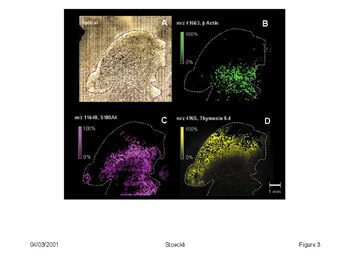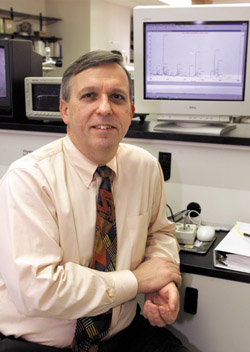
“Molecular photographs” taken by imaging mass spectrometry. The new technology was used to analyze a slice of human brain tumor (upper left), revealing the distribution of different proteins (represented by green, purple, and yellow). The “yellow” protein (bottom right) – identified as thymosin beta-4 – is concentrated at the outer edge of the growing tumor, suggesting that it is involved in the ability of tumor cells to grow and spread.
Technology expands ‘molecular photography’ options

Richard Caprioli
Move over Kodak. Vanderbilt University Medical Center investigators have developed a new way to take pictures – of the molecules in a slice of tissue, that is.
The technique, called Imaging Mass Spectrometry, offers scientists a new tool for visualizing where proteins are located in cells and tissues. This kind of information is important to understanding how proteins work and how they change in disease states. The Vanderbilt team applied the new technology, described in the April issue of Nature Medicine, to taking molecular photographs of normal and malignant brain tissue slices.
“One of our goals is to look at tumor tissues and attempt to find changes in expressed proteins that are the result of, or contribute to, tumor development,” said Richard Caprioli, Ph.D., director of the Mass Spectrometry Research Center. “We know from this and other work, for example, that the pattern of proteins expressed in the outer edge of a growing tumor is different from that of the interior, and that both of these are different from the normal tissue right next to the tumor.”
Caprioli hopes that someday the technology can be used to assess tumor margins during surgery and to detect molecular changes in a biopsy sample before a tumor has started any significant development.
The new Imaging Mass Spectrometry technology uses a standard MALDI (Matrix-Assisted Laser Desorption Ionization) mass spectrometer, an instrument that analyzes molecules based on their mass-to-charge (a property related to molecular weight). Caprioli and colleagues Markus Stoeckli, Ph.D. and Pierre Chaurand, Ph.D. modified the standard instrument’s electronics and software to image tissue slices.
To take the new molecular photographs, a chunk of tissue is first frozen so that it can be cut into super-thin slices. A tissue slice to be analyzed is then coated with a matrix material and introduced into the mass spectrometer, where a laser beam blasts successive spots on the tissue to release molecules for analysis. Each spot becomes a pixel in the final image, with each pixel containing a record of the molecules located in that tiny spot.
Computer processing can then be used to display the locations of selected proteins, based on their size. Caprioli’s team successfully used the new imaging technology to take molecular pictures of two types of tissues – normal mouse brain and human brain tumor grown in a mouse. In the brain tumor slices, the researchers identified proteins uniquely located in the tumor’s interior and at its invasive outer edge.
“The presumption is that molecules which are distinct for this invasive tumor region are related to the proliferation process and might serve as good diagnostic markers or molecular drug targets,” Caprioli said.
Caprioli is working with Vanderbilt-Ingram Cancer Center investigators Dr. Dennis E. Hallahan, Dr. Robert J. Matusik, Dr. Robert J. Coffey Jr., and Dr. Robert J. Weil to image proteins in prostate, colon and brain tumors and “determine what new molecular events are occurring,” he said.
Compared to other imaging techniques, Imaging Mass Spectrometry offers the advantage of not requiring a directed search for a specific protein. Using other techniques, investigators generally must add chemicals or antibodies that will mark a certain protein in order to determine its location. These strategies require that researchers know what molecule to look for, in order to select or produce the right antibodies, Caprioli said.
Imaging Mass Spectrometry, on the other hand, performs an unbiased scan of the tissue, cataloging all of the proteins it finds.
“You’re closest to finding out what’s going on in vivo if you don’t have to manipulate the tissue a great deal,” Caprioli said. “With Imaging Mass Spectrometry, there’s really minimal preparation of the tissue. It’s an important tool in the discovery process, where you don’t necessarily know what the target molecule is.”
Pharmaceutical companies want to use the new technology, Caprioli said, to find out where drugs end up in the body and how they are metabolized over time in these specific areas.
“Imaging Mass Spectrometry works well, and we’re very enthusiastic about its potential to significantly aid in new molecular discoveries,” he said.
The research is supported by the National Institutes of Health.
Imaging Mass Spectrometry is one of the tools available to Vanderbilt investigators through the Mass Spectrometry Research Center. Caprioli is also working with Andrew J. Link, Ph.D. to establish additional shared resources for proteomics, a broad area of research concerned with understanding proteins.













